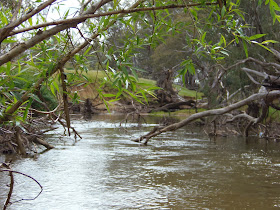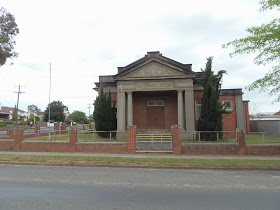I am very close to Greens Lake, the principal meeting place for "Grey Nomad Forum" members in Victoria where I intend to stay for a few weeks. I had read that there was a good free camp at English's Bridge, about 10 kms inland from Goornong on the Midland Hwy. It turned out to be a small area beside the Campaspe River and a low level bridge in the middle of farmlands where I spent a quiet night alone beside the Red Gums.
(Click on a Photo to enlarge)
Saturday, 30 November 2013
LAANECOORIE Vic
Laanecoorie is a small township on the Loddon River where I found a nice camping area right beside the river with a weir not far upstream. A few others also had discovered the place and it looked as though some had settled in for an extended stay. An honesty box existed, with the funds usually collected by a caretaker. However, another regular visitor told me that the caretaker recently had been sacked for stealing the money so there was no need to pay.
Laanecoorie is in the heart of the Golden Triangle, on the river crossing coming from the Tarnagulla and Waanyarra goldfields, that were operational in the 1850s to 1870s. The first bridge over the Loddon River was built in 1870, but was destroyed in the big flood of 1909 at the same time as the weir was breached. Laanecoorie Weir was constructed in 1891 and was the second irrigation scheme for Victoria. Sir John Monash (a famous engineer and W.W.1 General) designed and built a new bridge of reinforced concrete beam and slab construction, which still remains today.
(Click on a Photo to enlarge)
Laanecoorie is in the heart of the Golden Triangle, on the river crossing coming from the Tarnagulla and Waanyarra goldfields, that were operational in the 1850s to 1870s. The first bridge over the Loddon River was built in 1870, but was destroyed in the big flood of 1909 at the same time as the weir was breached. Laanecoorie Weir was constructed in 1891 and was the second irrigation scheme for Victoria. Sir John Monash (a famous engineer and W.W.1 General) designed and built a new bridge of reinforced concrete beam and slab construction, which still remains today.
(Click on a Photo to enlarge)
Thursday, 28 November 2013
TARNAGULLA Vic
Tarnagulla is situated in the goldfields of the Loddon Valley. A strange place that is still breathing but just. One could describe Tarnagulla as a ghost town with inhabitants, not unlike Terowie (the subject of a previous post). Although there are some buildings intact and occupied, just as many were abandoned or in ruins. Among the latter, the ruins of a number of what were once majestic Churches hinted that the town had a substantial population at some time in it's history.
Indeed, the discovery of gold in the area in 1852 led to growth that resulted in a population of 5000. Today the population is quoted as being about 150. By 1865, the town had reached its peak with a wide range of businesses operating including 4 hotels, 9 general stores, 3 surgeons, a share broker and watchmaker. In September of that year, the Tarnagulla court held its first sitting. Residents of the town included around 1,000 Chinese as well as groups of Greeks and Italians.
In 1853, the first gold nuggets were found near Tarnagulla at Nuggetty Gully.
From 1854, the focus of the miners turned to quartz mining with the discovery of the Poverty Reef. The reef was named by one of its discoverers, Mr. Hatt, in remembrance of Poverty Bay, New Zealand where he had been saved from drowning by a Māori woman. The Poverty lode was unusual in that the gold was found in large blocks of quartz.] Allegedly the richest pocket of reef gold ever found, more than 13.5 tonnes (430,000 ozt) of gold was recovered from Poverty Reef in 13 months from an area 3 metres wide and 120 metres deep. Remnants of the mine still remain in the centre of town.
It has also been reported that one pair of miners finding 86 lb (39 kg) of gold in a fourteen-day period. Many other large nuggets including one weighing 32 lb (14.5 kg) were allegedly found in the area. One undisputed fact is that a deposit of large nuggets, officially recorded as the greatest concentration ever taken from one small area anywhere in the world, was discovered on the eastern side of Tarnagulla in 1906 by John Porter. The deposit was named the Poseidon Lead. In 1912 the department of Mines published a report entitled "List of Nuggets found in Victoria". The list includes 98 ounces all found in the Poseidon Lead. The largest among them was Tarnagulla's most famous nugget, "The Poseidon Nugget" with a nett weight of 26.6 kg or 860 troy ounces! The mighty "Poseidon" was amazingly found at a depth of only 10 inches.The nugget was named after the racehorse Poseidon, winner of the 1906 Melbourne Cup. In fact the Tarnagulla Goldfields may not be exhausted with according to a 1996 report 420,000 ounces came from the area in the 19th century. It is said that nuggets are still being found. I reckon that I should have stayed in the area and dug up half the town, no wonder that there is still some life here.
(Click on a Photo to enlarge)
Indeed, the discovery of gold in the area in 1852 led to growth that resulted in a population of 5000. Today the population is quoted as being about 150. By 1865, the town had reached its peak with a wide range of businesses operating including 4 hotels, 9 general stores, 3 surgeons, a share broker and watchmaker. In September of that year, the Tarnagulla court held its first sitting. Residents of the town included around 1,000 Chinese as well as groups of Greeks and Italians.
In 1853, the first gold nuggets were found near Tarnagulla at Nuggetty Gully.
 |
| The remains of the Poverty Mine |
It has also been reported that one pair of miners finding 86 lb (39 kg) of gold in a fourteen-day period. Many other large nuggets including one weighing 32 lb (14.5 kg) were allegedly found in the area. One undisputed fact is that a deposit of large nuggets, officially recorded as the greatest concentration ever taken from one small area anywhere in the world, was discovered on the eastern side of Tarnagulla in 1906 by John Porter. The deposit was named the Poseidon Lead. In 1912 the department of Mines published a report entitled "List of Nuggets found in Victoria". The list includes 98 ounces all found in the Poseidon Lead. The largest among them was Tarnagulla's most famous nugget, "The Poseidon Nugget" with a nett weight of 26.6 kg or 860 troy ounces! The mighty "Poseidon" was amazingly found at a depth of only 10 inches.The nugget was named after the racehorse Poseidon, winner of the 1906 Melbourne Cup. In fact the Tarnagulla Goldfields may not be exhausted with according to a 1996 report 420,000 ounces came from the area in the 19th century. It is said that nuggets are still being found. I reckon that I should have stayed in the area and dug up half the town, no wonder that there is still some life here.
(Click on a Photo to enlarge)
The Church Ruins of Tarnagulla
 |
| The old Police Station |
 |
| The Police Lockup |
 |
| There was no Train around the corner, Sandra has moved |
Monday, 25 November 2013
ST ARNAUD Vic
St Arnaud, the next major centre that I came across on my journey SE was established during the gold rush era of the 1850s. It is named after French marshal Jacques Leroy de Saint Arnaud, commander-in-chief of the army of the East and one of quite a number of towns, streets etc. named after people and places of the Crimean War. The town servicing a population of around 2600 has retained its heritage buildings with the centrally located Town Hall being particularly impressive, one of the best that I have seen.






























































